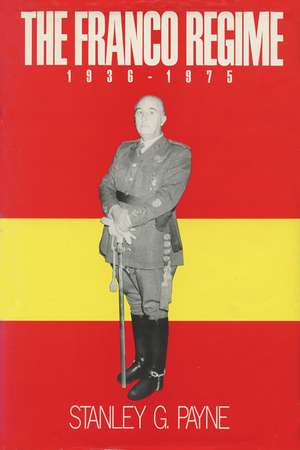The Franco Regime, 1936–1975
Autor Stanley G. Payneen Limba Engleză Paperback – 26 sep 2011
The history of modern Spain is dominated by the figure of Francisco Franco, who presided over one of the longest authoritarian regimes of the twentieth century. Between 1936 and the end of the regime in 1975, Franco’s Spain passed through several distinct phases of political, institutional, and economic development, moving from the original semi-fascist regime of 1936–45 to become the Catholic corporatist “organic democracy” under the monarchy from 1945 to 1957. Distinguished historian Stanley G. Payne offers deep insight into the career of this complex and formidable figure and the enormous changes that shaped Spanish history during his regime.
Preț: 396.15 lei
Nou
Puncte Express: 594
Preț estimativ în valută:
75.80€ • 78.20$ • 63.26£
75.80€ • 78.20$ • 63.26£
Carte tipărită la comandă
Livrare economică 26 martie-09 aprilie
Preluare comenzi: 021 569.72.76
Specificații
ISBN-13: 9780299110741
ISBN-10: 0299110745
Pagini: 677
Ilustrații: 52 illus., 5 maps
Dimensiuni: 152 x 229 x 41 mm
Greutate: 0.93 kg
Ediția:1
Editura: University of Wisconsin Press
Colecția University of Wisconsin Press
ISBN-10: 0299110745
Pagini: 677
Ilustrații: 52 illus., 5 maps
Dimensiuni: 152 x 229 x 41 mm
Greutate: 0.93 kg
Ediția:1
Editura: University of Wisconsin Press
Colecția University of Wisconsin Press
Recenzii
“The most substantial contribution to our understanding the political history of Francoist Spain. Its tone is gruff, its learning staggering.”—Raymond Carr, New York Review of Books
“With the publication of Stanley G. Payne’s massive and eminently judicious study we at last have the means of understanding the man and his regime. . . . The most solidly based and sanely balanced book yet to appear on this difficult subject.”—Paul Preston, New York Times
“A reference work essential for every historian of twentieth-century Europe.”—Robert Whealey, American Historical Review
Notă biografică
Stanley G. Payne is the Hilldale–Jaume Vicens Vives Professor of History Emeritus at the University of Wisconsin–Madison. His many books include Spain: A Unique History; Spain’s First Democracy: The Second Republic, 1931–1936; A History of Fascism, 1914–1945; and Fascism: Comparison and Definition, all published by the University of Wisconsin Press.
Cuprins
Illustrations
Preface
I. Nationalism in Spain: Liberal, Authoritarian, Fascist
1. The Problem of Spanish Nationalism
2. Origins of Authoritarian Nationalism in Spain
3. The Fascism of the Intellectuals
II. José Antonio Primo de Rivera and Falange Española, 1933–1936
4. José Antonio Primo de Rivera and the Founding of the Falange, 1933–1934
5. Jefe Nacional, 1934–1936
6. From Clandestiny to Civil War
7. The Death of José Antonio
III. The Falange Española Tradicionalista in the Facist Era, 1936–1945
8. Francisco Franco and the Formation of the Falange Española Tradicionalista
9. The FET during the Civil War, 1937–1939
10. The FET during the Climax of European Fascism, 1939–1941
11. The First Phase of a Long Defascistization
IV. The Movimiento Nacional During the Postfascist Era, 1945–1977
12. Partial Eclipse and Frustrated Resurgence, 1945–1958
13. The Last Phase of the Movimiento, 1959–1977
Conclusion
Notes
Index
Preface
I. Nationalism in Spain: Liberal, Authoritarian, Fascist
1. The Problem of Spanish Nationalism
2. Origins of Authoritarian Nationalism in Spain
3. The Fascism of the Intellectuals
II. José Antonio Primo de Rivera and Falange Española, 1933–1936
4. José Antonio Primo de Rivera and the Founding of the Falange, 1933–1934
5. Jefe Nacional, 1934–1936
6. From Clandestiny to Civil War
7. The Death of José Antonio
III. The Falange Española Tradicionalista in the Facist Era, 1936–1945
8. Francisco Franco and the Formation of the Falange Española Tradicionalista
9. The FET during the Civil War, 1937–1939
10. The FET during the Climax of European Fascism, 1939–1941
11. The First Phase of a Long Defascistization
IV. The Movimiento Nacional During the Postfascist Era, 1945–1977
12. Partial Eclipse and Frustrated Resurgence, 1945–1958
13. The Last Phase of the Movimiento, 1959–1977
Conclusion
Notes
Index
Descriere
The history of modern Spain is dominated by the figure of Francisco Franco, who presided over one of the longest authoritarian regimes of the twentieth century. Between 1936 and the end of the regime in 1975, Franco’s Spain passed through several distinct phases of political, institutional, and economic development, moving from the original semi-fascist regime of 1936–45 to become the Catholic corporatist “organic democracy” under the monarchy from 1945 to 1957. Distinguished historian Stanley G. Payne offers deep insight into the career of this complex and formidable figure and the enormous changes that shaped Spanish history during his regime.










